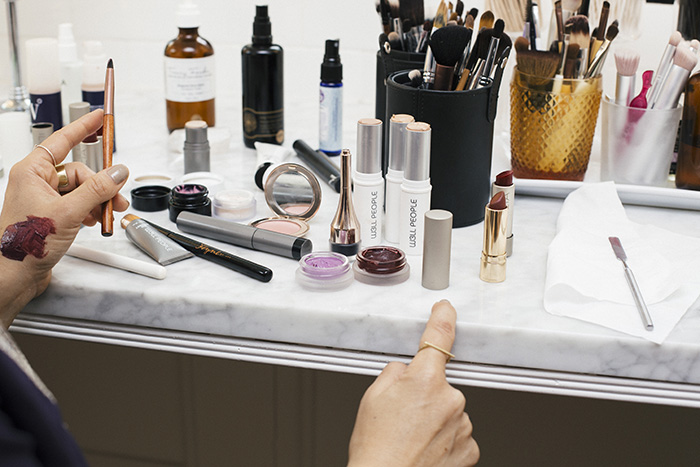FDA on September 10, 2019, issued a safety alert telling consumers to cease the use of cosmetics from Beauty Plus. The agency discovered dangerous asbestos traces in four of the company’s talc-based products. Asbestos is a human carcinogen that can cause cancer with enough exposure.
Testing revealed asbestos was in the company’s bronzer, shimmer bronzer, a beauty palette, and a matte blush. FDA reported this is the second time Beauty Plus has been involved in a voluntary recall because of asbestos contamination.
Last May, FDA warned Americans to not use two products: Claire’s JoJo Siwa Makeup Set and Beauty Plus Global Effects Pallette 2. Both products are made with talc.
Environmental Working Group Blasts Asbestos-Containing Cosmetics
According to the website Environmental Working Group (EWG), it is troubling to consider how many consumers have used talc-based cosmetic products that could be contaminated with asbestos, when inhaling even a small amount of asbestos can cause cancer years later. (EWG.org)
EWG’s Senior Vice President for Government Affairs Scott Faber told the media that while consumers should be ‘alarmed and outraged,’ it is not really a surprise; federal laws that cover the cosmetics industry have not been changed since 1938.
Faber noted his organization urges consumers to listen to FDA’s warning and avoid using these cosmetics entirely. EWG hopes Congress will realize the current regulatory system that allows the cosmetic industry to work outside of FDA’s authority should end.
Asbestos and Talc Form Together in Nature
Talc and asbestos form in the earth from the same type of rock. In many parts of the world, talc deposits are marred with asbestos fibers. There has been no safe level of asbestos exposure ever established. Asbestos fibers can lodge deep in lung tissue. Years later, DNA mutations can cause fatal mesothelioma to develop. Mesothelioma is a painful cancer of the lung lining that is only caused by asbestos exposure.
Congress Pushing for Cosmetics Reform Legislation
A bipartisan group of federal legislators in the US House and Senate are pushing for major cosmetic reform regulations that could fix this problem. Rep. Debbie Dingell (D-MI) has introduced a bill in the House that would mandate warning labels on cosmetics that may contain asbestos and are sold to children.
In March 2019, the US House had an oversight hearing that studied asbestos-contaminated cosmetics after an earlier FDA test that discovered three cosmetics containing talc were contaminated with asbestos. These products were sold by Claire’s. Faber provided testimony in front of the House committee. He warned there are many thousands of talc-based cosmetics that may have asbestos in them.
Faber said EWG discovered at least 2,000 cosmetics and other personal care products that have talc, such as 1,000 loose powders or pressed powders that have a risk of inhalation. Even a minute amount of talc in asbestos can lead to mesothelioma with enough exposure. Mesothelioma tends to develop decades after the asbestos exposure occurs.
Asbestos – One of the Most Hazardous Substances in the World
Asbestos has been recognized as a lethal human carcinogen for decades. It is estimated that 15,000 Americans perish annually from diseases related to asbestos, such as mesothelioma and asbestosis. In 2018, a peer-reviewed study determined the yearly death toll from exposure to asbestos could be a lot higher – almost 40,000 Americans per year, and 250,000 globally.
Unfortunately, no US law bans asbestos in cosmetics. But asbestos has been outlawed in 50 countries. But it is still legal for use in the United States. FDA urges companies that mine talc to be careful in their selection of talc mines to avoid contamination with asbestos. But it lacks regulatory authority on cosmetic products manufactured in this country.
Johnson & Johnson’s Many Legal Headaches From Asbestos-Laced Talcum Powder
In recent years, Johnson & Johnson has been under legal and political fire for some of its famous Baby Powder being possibly contaminated with asbestos. There have been thousands of personal injury lawsuits filed by consumers who were diagnosed with mesothelioma or ovarian cancer after using baby powder for their daily hygiene regimes. (NBCnews.com)
During some of the lawsuits, J&J internal documents were released during the trial. A Reuters study of some of those internal memos discovered the shocking truth: From 1971 until the early 2000s, J&J’s raw talc and even finished powders sometimes did test positive for small levels of asbestos. It also was found that company executives, scientists, doctors, and attorneys knew about the contamination. However, they did not know what to do about it and hid the information from the public and from FDA.
Court documents also revealed that in 1976, FDA was considering limits on asbestos in talc cosmetics. But J&J said no asbestos was found in any samples of products made from 1972 to 1973. J&J failed to note that a minimum of three tests by three different laboratories from 1972-1975 had discovered asbestos in its talc.
If You Have Cancer After Using Cosmetics, Talk to a Personal Injury Attorney Now
If you have developed mesothelioma or ovarian cancer from exposure to talc-based cosmetics, you could be eligible to file a personal injury lawsuit for your medical bills, pain and suffering and lost wages. Talk to our office to determine if you have a legal case.






